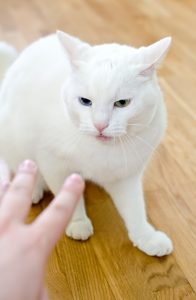By the Pet Professional Guild Cat Committee

Cats typically give subtle signals of overstimulation during petting that may be missed or ignored, which may result in a bite or scratch © Can Stock Photo/dmitrimaruta
Petting-induced aggression is a commonly reported feline behavior issue whereby adoring owners often find themselves at a loss to understand why their beloved kitty is so accepting of their affection one moment, only to go completely on the offensive the next.
Important reminders about the behavior:
- As both a predator and prey species, cats need to be highly sensitive to their environment to survive, which includes being sensitive to touch. Cats have touch receptors all over their bodies, some of which are continually stimulated during petting.
- Cats typically give subtle signals of overstimulation during petting that may be missed or ignored, which may result in a bite or scratch. When these signals are repeatedly missed, some cats learn to forego the subtle signals and quickly escalate to biting or scratching when touched.
- Every cat has individual preferences for petting and physical contact, and it is the humans’ job to determine how much of each a cat wants, in what forms, and when, and to allow the choice to always be the cat’s.
- Most cats prefer brief but frequent petting sessions focused around the head and neck, similar to the active friendly contact they may have with other cats called allogrooming (mutual grooming), which takes place in very short sessions on the head and neck only.
Management and safety information:
- Avoid petting cats when they are eating or drinking, sleeping, grooming, using the litter box, hiding, playing, or excited or stimulated.
- Always pay attention to the cat’s body language when petting. If you are unable to pay attention, don’t touch the cat.
- Never pick up or hold a cat still for petting.
- A cat showing her tummy is not issuing an invitation to pet it. Grabbing and biting you when you touch a cat’s tummy is a reflex; she cannot help herself.
- Never tease, provoke, or roughhouse with a cat. Even though a cat might engage in this sort of play, it is likely to trigger fear and defensive behavior that often results in biting or scratching any time a hand approaches.
- Never discipline or punish a cat for grabbing, biting, or scratching during petting. She will not understand, and it could harm your relationship with her. Instead, assess what caused her to react that way and change your
Behavior modification skills:
With petting-induced aggression, it is the humans who must change their behavior to accommodate the cat’s preferences and choices. The cat must be allowed to control the type and amount of physical contact.
Assess what the cat is doing and her energy level and body language. If the cat is calm and relaxed and not engaged in one of the activities listed in the first bullet in the previous section, it is okay to “ask the cat permission” to pet (aka a consent test):
- Remain calm and talk to the cat in a soft, quiet tone of voice.
- Avoid direct eye contact. Slowly blink and turn your head away from the cat.
- Extend a relaxed finger or hand toward the cat’s nose.
- If the cat makes contact and rubs on and leans into your hand, she is saying, “Yes, please,” to some petting.
- If the cat does not make contact or sniffs and pulls her head away or walks away, she is saying, “No, thank you.” Don’t be insulted! It’s just information. She is not interested in engaging at that time. Simply leave her alone.
- Use one hand to gently pet the cat around the head, cheeks, neck, and shoulders in the same direction as the fur.
- Pet very briefly (three or four strokes) and pay attention to the cat’s body language. Cats will signal when they are overstimulated or have had enough. STOP PETTING WHEN YOU SEE IT—simply take your hand off the cat.
- Common signs of overstimulation (typically, you’ll just see one):
- Vocalization other than purring.
- Ears back, sideways, or flat.
- Tail flicking or lashing.
- Skin twitching or rippling.
- Head turns toward the hand that’s petting.
- Pupils slit or very dilated.
- Claws out.
- Whiskers forward.
- Head, legs, or shoulders stiffen.
- Paw raises.
- Body is repositioned away from the hand or moved into a crouch position.
- If the cat moves away, walks away, or otherwise ends the interaction, don’t pursue.
Timeline:
- The timeline for resolving petting-induced aggression depends on how well and consistently everyone who comes into contact with the cat follows the above guidelines. If everyone in the home adheres to the guidelines except one person, who continues to roughhouse with the cat, the aggression will persist.
- As a cat learns that she will not be petted when or where she doesn’t want to be petted, she will learn to trust you and will gradually allow more petting.
- You must be aware of and respect your cat’s “stop-petting” signal for the life of the cat.
Note: Every cat is an individual, and behavior is complex. If you need help training your cat, please seek out
a qualified feline behavior professional: https://petprofessionalguild.com/Find-Your-Feline-Professional
© 2019 The Pet Professional Guild Feline Committee
